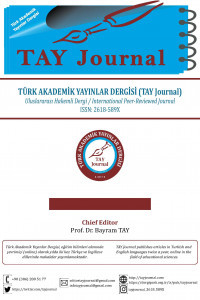Sınıf Öğretmenlerinin Örtük Bilgiyi Kullanma Düzeyleri
Sınıf öğretmenleri, örtük bilgi, kullanma düzeyi
Levels of Classroom Teachers' Use of Tacit Knowledge
Classroom teachers, tacit knowledge, level of use,
___
- Ay, A., & Başıbüyük, A. (2022). Sosyal bilgiler dersinde öğrenme amaçlı yazma etkinleri kullanımına ilişkin öğrenci deneyimleri [Learner experiences in the social studies lesson using writing-to-learn activities]. Inonu University Journal of the Faculty of Education, 23(2), 1112-1131. https://doi.org/10.17679/inuefd.1146311
- Büyüköztürk, Ş., Kılıç Çakmak, E., Akgün, Ö. E., Karadeniz, Ş., & Demirel, F. (2013). Bilimsel araştırma yöntemleri [Scientific research methods]. (14th edition). Pegem Akademi.
- Chugh, R. (2015). Do Australian Universities Encourage Tacit Knowledge Transfer? Proceedings of the 7th International Joint Conference on Knowledge Discovery, Knowledge Engineering and Knowledge Management. pp. 128–135. https://doi.org/10.5220/0005585901280135.
- Çakır, P., İra, N., & Yenal, T. H. (2020). Sınıf öğretmenlerinin örtük bilgi hakkındaki görüşleri [Wiews of classroom teachers about tacit knowledge]. International Journal of New Trends in Arts, Sports & Science Education, 9(4), 136-144.
- Doğan, H. (2007). İşletmelerde örtük bilginin somutlaştırılması ile olası stratejik risk sendromlarına ilişkin çözüm önerileri [Struggles for transforming tacit knowledge into an explicit/common value form in firms and solution proposals for strategic risk sendroms probably appeared in transformation process]. Gazi Üniversitesi İktisadi ve İdari Bilimler Fakültesi Dergisi, 9(2), 143-160.
- Feyerabend, P. (2015). The Tyrrani of science [Bilimin Tiranlığı] (1. Edition). (B. Yıldırım, Trans. Ed.). Sel.
- Geiger, D., & Schreyögg, G. (2012). Narratives in knowledge sharing: Challenging validity. Journal of Knowledge Management, 16(1), 97–113.
- Goffin, K., & Koners, U. (2011). Tacit knowledge, lessons learnt, and new product development. Journal of Product Innovation Management, 28(2), 300–318. https://doi.org/10.1111/j.1540-5885.2010.00798.x.
- Héder, M., & Paksi, D. (2018). Non-Human Knowledge According to Michael Polanyi. Tradition and Discovery: The Polanyi Society Periodical. 44(1), 50–66. https://doi.org/10.5840/traddisc20184418
- Howells, J. (1996). Tacit knowledge, innovation and technology transfer. Technology Analysis and Strategic Management, 8(2), 91-107.Ira, N., & Bulut, S. (2018). Organizational power resources and psychological capital relations in schools. International Online Journal of Primary Education, 7(2), 17-25.
- Nonaka, I., & Takeuchi, H. (1995). The knowledge-creating company: How Japanese companies create the dynamics of innovation. Oxford University.
- Patton, M. Q. (2014). Qualitative research & Evaluation methods. M. Bütün & S. B. Demir (Tras. Eds.). Pegem Akademi.
- Polanyi, M. (1958). Personal Knowledge: Towards a Post- Critical Philosophy. University of Chicago.
- Polanyi, M. (1966). The Tacit dimension. University of Chicago.
- Smith, E. A. (2001). The Role of tacit and explicit knowledge in the workplace. Journal of Knowledge Management, 5(4), 311-321.
- Tekindal, M., & Uğuz Arsu, Ş. (2020). Nitel araştırma yöntemi olarak fenomenolojik yaklaşımın kapsamı ve sürecine yönelik bir derleme [A review on the scope and process of phenomenological approach as a qualitative research method]. Beyond the Horizon of Scientific Journal, 20(1), 153-182.
- Wikipedia contributors. (2022, August 4). Tacit knowledge. In Wikipedia, The Free Encyclopedia. Retrieved 11:00, October 29, 2022, from https://en.wikipedia.org/w/index.php?title=Tacit_knowledge&oldid=1102407877
- Yıldırım, A., & Şimşek, H. (2018). Sosyal bilimlerde nitel araştırma yöntemleri [Qualitative research methods in the social sciences]. (11. edition). Seçkin.
- Yıldırım, B. F., & Özdemirci, F. (2019). Kurumlarda örtük bilginin yapay zekâ destekli tavsiye sistemleri aracılığıyla ortaya çıkarılması [Revealing tacit knowledge ın organizations through recommender systems, supported by artificial intelligence]. Bilgi Yönetimi Dergisi, 2(1), 34-43. https://doi.org/10.33721/by.544239
- ISSN: 2618-589X
- Başlangıç: 2017
- Yayıncı: Bayram TAY
Karar Verme Becerisi: Nasıl Daha Doğru Karar Verilir?
Osman SAMANCI, Merve MAZLUMOĞLU
Kent Yoksulluğunun Etkileri: Öğrencilerin Deneyimleri Üzerinden Bir Değerlendirme
Orhan KAHYA, Perihan KORKUT, Kasım YILDIRIM, Sergender SEZER, Tuğba HOŞGÖRÜR, Mirace KARACA EVREN, Mine KİZİR, Eda YEŞİL, Vural HOŞGÖRÜR
Sınıf Öğretmenlerinin Örtük Bilgiyi Kullanma Düzeyleri
Okul Öncesi Dönemde Öğrenme Güçlüğü ile İlgili Yapılan Lisansüstü Çalışmaların İncelenmesi
İlkokul Müdürlerinin Liderlik Davranışlarının İncelenmesi: Fenomenolojik Bir Çalışma
Emre SÖNMEZ, Zeki ÖĞDEM, Emre ER
Aykut ŞAHİN, Yunus Emre KARAKAYA
İlkokul Öğrencilerinin Dört İşlem Sembol Hatalarının Belirlenmesi ve Çözüm Önerileri
Üniversite Öğrencilerinin Covid-19 Pandemisi Sonrasına Yönelik Yaşadıkları Durumların İncelenmesi
